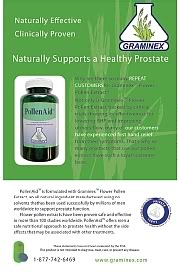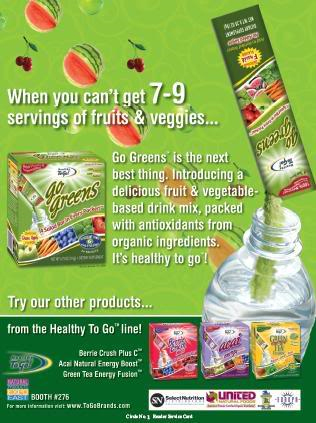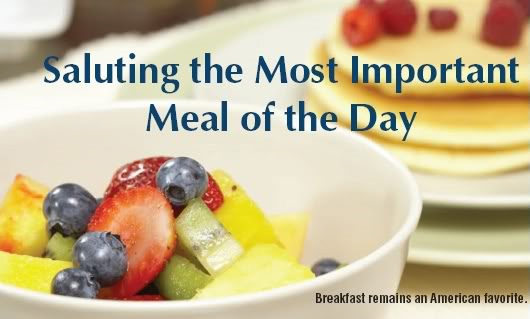You are what you eat... especially if it’s the first thing you eat. Breakfast has been and always will be the most important meal of the day. Eating a frosted doughnut over granola and yogurt may be the factor that decides the amount of stress that will accompany your daily activities.
“Studies have shown that individuals who eat breakfast have more energy and perform better throughout the day,” says Carol Ullner, director of marketing at 1-2-3-Gluten Free, Inc., located in Pittsburgh, PA. In fact, a recent study published in the journal Pediatrics found that teenagers who regularly eat breakfast maintain a more physically active lifestyle throughout adolescence. Moreover, the researchers suggested that eating a healthy breakfast regularly in your teens could help avoid overeating later in life and result in less weight gain and a lower body mass index. With teen obesity nearly tripling in the past two decades, the link between obesity and breakfast habits may call for added attention (1).
In addition, Kim Bremer, category group manager at Hain Celestial, based in Melville, NY, highlights work by Ann Yelmokas, a nutrition scientist at Tufts University (USDA Nutrition Research Center), that found, “Women who eat breakfast, especially those who eat cereal, are less likely to be overweight than women who don’t.” Yelmokas also found, says Bremer, that “Ninety-six percent of everyone who loses weight and keeps it off eats breakfast every day.”
If your customers fail to realize the importance of a morning meal, ask them to think about any weight-loss or muscle-building diet they have been exposed to. “Ninety-nine percent of the time you have to make sure you have breakfast,” says Maria Emmer-Aanes, director of marketing at the Canadian-based Nature’s Path Organic Foods, Inc. The reason, she says, is that foods are more efficiently used when consumed at the start of the day.
Because of this, says Brad Halpern, chief “Eggsecutive” at Eggology, Inc., located in Canoga Park, CA, “The focus has been placed on making this first meal one of specific nutrients tailored to specific activities/tasks performed that day.” While research has proven the importance of sleep, he adds, only now have data begun “to correlate the significance of the nutrition immediately after sleeping.”
 The data are particularly convincing with kids, says Bremer. “There are multiple scientific studies that show that eating breakfast improves academic performance including improved math scores, better working memory and increased verbal skills.” Eating breakfast, she adds, has been found to improve attitude toward school and lessen depression, anxiety and hyperactivity. “Likewise,” she says, “adults are better able to perform in an office or work environment if they have taken the time to eat breakfast.”
The data are particularly convincing with kids, says Bremer. “There are multiple scientific studies that show that eating breakfast improves academic performance including improved math scores, better working memory and increased verbal skills.” Eating breakfast, she adds, has been found to improve attitude toward school and lessen depression, anxiety and hyperactivity. “Likewise,” she says, “adults are better able to perform in an office or work environment if they have taken the time to eat breakfast.”Speaking from experience, Arnold Coombs, general manager of Coombs Family Farms, located in Brattleboro, VT, says his family made sure breakfast was eaten, because they knew they had a long day of farm work ahead of them. “These days, too many people rely on caffeine and refined sugars to get them through the day. While I like a good cup of coffee as much as the next person,” he admits, “there’s nothing like a farm hand breakfast with real farm-fresh ingredients first thing in the morning.”
The problem with this is that people don’t have enough time to feed themselves, let alone their children. Nevertheless, the popularity of breakfast foods with American consumers is still solid. Phil Lempert, also known as the “Supermarket Guru” on NBC’s Today Show, says, “Breakfast foods are ingrained in our daily routines, even if sit-down meals have given way to less time-consumptive breakfast bars or muffins to go.” Analyzing data from the Nielson Strategic Planner, Lempert notes that while there were declines in the equivalized unit volume (EUV) of the top five breakfast foods in the 52 weeks ending August 11, 2007 (ready-to eat cereal; fresh eggs; refrigerated bacon; breakfast sausage and hot cereal), the breakfast market saw increases in more convenient options, which made up the slack. “The sales pattern,” he said, “seems more reflective of time constraints or healthful choices than changing tastes (2).”
Staple breakfast items have actually been quite similar for the past 20 years according to a 2007 report by the Port Washington, NY-based NPD Group. Despite some reordering, the report, which analyzed what types of foods parents fed their children, showed that only one entry on its top 10 breakfast food list differed between the 1985–1987 report and the 2005–2007 report. While “fruit drinks” graced the 1987 top 10, they were replaced by waffles in 2007. The remaining items included cold cereal, a glass of milk, fruit juice, eggs, fruit, toast, pancakes, hot cereal and bacon. However, the report found a decline with egg and bacon purchases and an increase on items such as yogurt, bars, toaster pastries and fruit (3). As in the Nielsen report, convenience also seems to be driving these sales trends.
 A New Morning
Although the NPD Group’s survey results suggest that a traditional breakfast will most likely stand the test of time, consumers are more health conscious than ever before and are willing to trade in their Eggos for a whole grain and fiber-rich waffle. As a retailer, the merits of carrying plenty of breakfast food options should come as no surprise. America’s consumers love these items not only in the morning, but also at lunch and dinner.
A New Morning
Although the NPD Group’s survey results suggest that a traditional breakfast will most likely stand the test of time, consumers are more health conscious than ever before and are willing to trade in their Eggos for a whole grain and fiber-rich waffle. As a retailer, the merits of carrying plenty of breakfast food options should come as no surprise. America’s consumers love these items not only in the morning, but also at lunch and dinner.When picking up a new product line, retailers should keep in mind that variety is key, convenience is favored, but Emmer-Aanes warns, taste is king. “As people’s taste buds change away from sugar and salt, they begin to appreciate the texture and benefits of whole foods,” she says. In addition, she says, “It makes them feel better about what they’re eating.”
No single breakfast plan is right for everyone, however, and that’s why it is essential to carry different types of products to satisfy all of your clientele’s needs. “The thought that one dietary regimen is right for everyone is misleading,” says Stephanie Robbins, director of marketing at Pamela’s Products of Ukiah, CA. “Of course,” she adds, “fresh, wholesome food is always ideal, but how those are prepared needs to be decided on a case-by-case need.”
Halpern notes, “Proteins, whole grains and fruits are mandatory for human performance [and] saturated fats remain the demon of breakfast foods.” Having options in each of these groups and explaining to your customers their importance will further assist your customers.
It is just as important to explain what they shouldn’t be eating as well. “Stay away from empty calories,” says Tristan Kampman of San Rafael, CA-based Galaxy Granola. Also suggesting whole grains, Kampman says that people should avoid items that cause a spike in blood sugar and thus burn through energy quickly. “If you find yourself hungry two hours after eating breakfast, you probably didn’t eat the right food,” he says.
Nature’s Path’s Emmer-Aanes also comments that organic foods are preferred, especially for children and adolescents. “Young bodies are more impacted by what you do to them, and pesticides and herbicides affect a child more intensely while they’re growing.” With organic sales steadily increasing each year, it appears that the general public is also leary of these chemicals.
 Product Trends
With all the options consumers should avoid, the natural products industry is leading the way in areas to indulge. The public is also being flooded with nutrition facts, and Kampman says, “We believe consumers are beginning to look for more than just low-sugar and whole grains.” Moreover, he notes, “Consumers are searching for breakfast foods that also provide functional benefits. As a result, ingredients like protein, omega-3 fatty acids and antioxidants are increasingly integrated in breakfast foods.” Kampman, like many others, doesn’t believe this trend will slow anytime soon.
Product Trends
With all the options consumers should avoid, the natural products industry is leading the way in areas to indulge. The public is also being flooded with nutrition facts, and Kampman says, “We believe consumers are beginning to look for more than just low-sugar and whole grains.” Moreover, he notes, “Consumers are searching for breakfast foods that also provide functional benefits. As a result, ingredients like protein, omega-3 fatty acids and antioxidants are increasingly integrated in breakfast foods.” Kampman, like many others, doesn’t believe this trend will slow anytime soon.This functional trend has led Galaxy Granola to make its granola products “with a boost.” A single serving of the company’s MeteorBites snack packs include whole grains, fruit and key functional ingredients like flax, hemp and quinoa. The product is also sweetened with agave so there is no spike in blood sugar to provide long-lasting nutritional support.
Emmer-Aanes agrees that functional ingredients are really hot—especially flaxseed. Its FlaxPlus cereals, which now come in Pumpkin Raisin Crunch and Red Berry Crunch as well as other varieties, have benefited from this consumer enthusiasm, she says. Gaining even more credit are functional products directed toward children. Nature’s Path EnviroKidz line of children’s cereal includes Penguin Puffs, Gorilla Munch, Panda Puffs and more, which are packed with whole grains and contain 8 grams or less of sugar.
Also playing in the children’s sector, Hain Celestial’s Earth’s Best brand produces Sesame Street instant oatmeal and cold cereals that are fortified with eight essential vitamins and minerals including iron, zinc and B vitamins, and Sesame Street Frozen Organic Mini Waffles, which are also specially fortified for kids. For adults, Hain’s Arrowhead and Health Valley organic cereals are made with whole grains and fortified with vitamins and minerals.
As far as protein goes, customers should not forget about eggs. While some will steer clear of the breakfast staple, healthier and fresher options have undoubtedly created consumer appeal. Eggology, Inc., for instance, produces organic egg whites that are certified humane. Eggs, Halpern says, “offer the only pure all-natural protein available.” In addition, he notes, “Egg whites are fat-free and the perfect nutrition for breakfast and human performance.”
Carrying healthy preferably certified organic, breakfast meats may also appeal to some of your clientele. Coombs adds that organic soy and meat-substitute products have seen an increased presence in the marketplace. This can give your vegetarian and vegan customers a protein option in the morning.
It is also apparent that probiotic items have become popular as the sales of yogurt increase. Sheryl Kesey Thompson, co-founder and general manager of Springfield Creamery, Inc., located in Eugene, OR, also comments on the growing interest of probiotic drinks. “Some of our customers have told us that they have swapped Nancy’s Organic Low-Fat Kefir for their morning smoothie. There’s no prep time so it’s perfect for a fast and healthful breakfast, and it’s packed with probiotics.” The company offers many cultured dairy products that can be mixed with fruit or granola, and also has Organic Cultured Soy for vegans or those with lactose intolerance.
“People don’t want to eat eggs and whole grain toast every day and are looking for ways to liven up breakfast,” advises Ullner. While staple breakfast products are essential for store sales, introducing new and tasty options are just as important. In addition, consumers with allergies can find difficulties finding new foods to enjoy, making allergen-free foods another emerging market. When choosing allergen-free products to pick up, however, it is important to take into account that “families who have one or more members with food allergies or intolerances don’t want to have to make several different options for breakfast,” explains Ullner. “It’s easier if everyone will eat the same thing so it’s important that allergen-free breakfast foods taste good to everyone, not just the one member of the family who must eat a restricted diet.”
1-2-3 Gluten Free makes all of its products in a gluten- and allergen-free facility. “Buckwheat,” says Ullner, “is a healthy gluten-free grain and the addition of pumpkin, bananas, blueberries and other fruits [which can be added to its Allie’s Awesome Buckwheat Pancake Mix] ups the fiber and nutritional value for your family.” Other breakfast products offered by the company include Meredith’s Marvelous Muffins/Quick Bread Mix and Aaron’s Favorite Rolls Mix. The boxes include recipes that can help parents sneak vegetables and other healthy ingredients without their unsuspecting child even knowing.
Baking mixes, in general, are becoming another emerging trend in the natural products industry. “As with all of the natural foods sector,” says Robbins, “unadulterated ingredients such as those in [Pamela’s] products is always the most important factor in food production. People want their food to retain as much nutrition as possible.”
Emmer-Aanes of Nature’s Path says that this has lead manufacturers to look for whole grain crops that, in the past, were not mass-produced. “More sacred grains like spelt and kamut that are not over processed and also good for people with a gluten intolerance,” she says, have taken center stage.
Robbins notes that Pamela’s Baking and Pancake Mix is a top seller, and the company has created numerous breakfast-related recipes that it posts on its Web site so customers don’t get tired of the same old thing. Mixes, like those offered by Pamela’s, 1-2-3 Gluten Free and Nature’s Path, give customers the opportunity to be creative over the weekend when they have more time. Since waffles, pancakes and French toast can be frozen and reheated, your customers will have time for a quick homemade breakfast during the week.
With favorites like these, your customers, says Coombs, shouldn’t deny themselves a touch of sweetness. “Life is too short,” he says. “Try natural sweeteners with a low-glycemic index like our Coombs Family Farms pure and organic maple syrup or maple syrup granules.” In particular, he says, “More people are choosing pure maple syrup over non-pure maple syrup for their pancakes these days.” It doesn’t stop there, though. “It’s a hot flavor profile for everything from granola to yogurt to breakfast meats. And that’s just for breakfast,” he says.
With all these options, and still many more out there, retailers should look to represent the entire breakfast category in their store. What works for some won’t work for others, but one thing is set in stone: Don’t skip the most important meal of the day! WF
References
- M.T. Timlin, et al., “Breakfast Eating and Weight Change in a 5-Year Prospective Analysis of Adolescents: Project EAT (Eating Among Teens),” Pediatrics, 121: e638–e645 (Mar 2008).
- P. Lempert, “Breakfast Cravings in the a.m., or Any Time of Day,” Facts, Figures, and the Future e-newsletter (Sept. 2007).
- The NPD Group, “Eating Patterns in America,” The NPD Group, Port Washington, NY (Oct. 2007).









